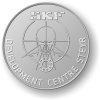Hello forum,
A strange thing happened. I was asked to make a die for making one medallion. Now the problem is, I've never done any dies before and I know very little about the process. Of course I told this to the customer, but he insisted that I'd give it a try at least, if it doesn't work out, then no problem, I gained experience.
I know that it will be used on 60 ton press for silver. The die shape is 45mm (2 3/4 in) circular with probably the same height. I need to make 2 sides - obverse and reverse (I think that's what they're called).
Now the questions:
1. On what metal I have to do it? Probably something that is hardens... But use regular carbon steel, special diemaking steel or something else? Die steel that I have, D2, I think is very-very hard to engrave.
2. As I understand the images on dies have to be reversed and cut into the metal? Not like relief engraving which removes the background, but I have to "remove" the image from metal.
3. Which tools to use? I have engraver, of course. But as this will be quite big, probably I'd need something to help with faster metal removal? The rotary tool? Which tips?
4. How long do you think it could take time? 10 hours, 100 hours? More? Less?
5. Finishing... How smooth the surface has to be? Mirror? 2000 grit? 400?
6. Anything, ANY information you can point me to and that would help me on finishing this.
Just in case I say it again. The customer knows and I've told him that I probably can't produce good enough result, so no worries there. I just do my best and have fun with it.
Thanks!
Viljo
A strange thing happened. I was asked to make a die for making one medallion. Now the problem is, I've never done any dies before and I know very little about the process. Of course I told this to the customer, but he insisted that I'd give it a try at least, if it doesn't work out, then no problem, I gained experience.
I know that it will be used on 60 ton press for silver. The die shape is 45mm (2 3/4 in) circular with probably the same height. I need to make 2 sides - obverse and reverse (I think that's what they're called).
Now the questions:
1. On what metal I have to do it? Probably something that is hardens... But use regular carbon steel, special diemaking steel or something else? Die steel that I have, D2, I think is very-very hard to engrave.
2. As I understand the images on dies have to be reversed and cut into the metal? Not like relief engraving which removes the background, but I have to "remove" the image from metal.
3. Which tools to use? I have engraver, of course. But as this will be quite big, probably I'd need something to help with faster metal removal? The rotary tool? Which tips?
4. How long do you think it could take time? 10 hours, 100 hours? More? Less?
5. Finishing... How smooth the surface has to be? Mirror? 2000 grit? 400?
6. Anything, ANY information you can point me to and that would help me on finishing this.
Just in case I say it again. The customer knows and I've told him that I probably can't produce good enough result, so no worries there. I just do my best and have fun with it.
Thanks!
Viljo



























